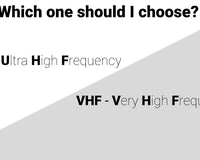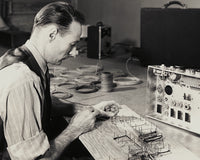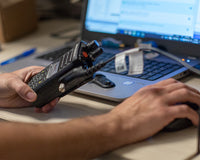Here's our recommendations for new battery use, storage, and care
Advances in battery technology have helped make two-way radios dramatically smaller and more powerful. And while the lithium-ion battery (first sold commercially around 28 years ago) has become the industry standard, it is not the only choice. Understanding the available options and learning a few simple rules will extend battery life and improve radio performance.
Each type of battery has a different standard battery life and service requirements. It is important to remember that these estimates can vary widely depending on environments and charging methods.
Typical Battery Lifespan
-
Nickel-cadmium (NiCd): 2 - 3 Years
-
Nickel-Metal-Hydride (NiMH): 1 - 2 Years
-
Lithium-ion (Li-ion): 1.5 - 2 Years
How to check your batteries age
While some battery manufacturers have a dating system, others do not. We always recommend marking your batteries with a date so you know how long you have had them. You should do this even with manufacturer dated batteries as date codes on the batteries only denote when it was assembled, not sold to you.- Remove the battery from your radio
- Look at the white label on the front of the battery
- Near the barcode will be a group of 4 digits. These are the year and week your battery was made.
Example: 1518 means 2015, Week 18 or April 27th - May 3rd, 2015

Best charging practices for all battery types
Initialize your new battery
New batteries must be fully charged before their first use. This will “initialize” the battery and ensure it operates at its maximum capacity. NiCd/NiMH typically charge in 14-16 hours, and Li-ion batteries take between 2-3 hours.
Do not use the radio while it is charging
Charge your radios in a dry cool environment
Temperature can have a major impact in your radio’s battery life. You can lose as much as 25% operating time if your battery charges in a hot environment. Additionally, charging in extreme cold (-4 degrees F and below) can dramatically decrease total battery capacity.
Ensure proper connection in the charger
Almost all two-way batteries can be charged while not attached to the radio. This is due to a tab system between the battery and the charger that aligns the contact points. The radio/battery combo or just the battery should slide smoothly into the charger.
Remove from charger after the battery is full
If you know your radio will not be used for a while, it is best to remove it from the charger. This reflects back to the do not use the radio while charging section above, as continuous charging shortens the battery’s life.
Nickel-Metal-Hydride (NiMH) Charging Rules
- Charge fully each time
- Condition batteries to reduce the memory effect
- Can be stored completely discharged
- Increased temperature while charging is normal
Lithium-ion (Li-ion) Charging Rules
- Should charge in 1-3 hours depending on charger type
- Partial charges are less of a concern than Ni batteries
- Partial discharges and more frequent charging are preferred
- No charging in freezing temperatures
- Should be stored with a partial charge 30% - 50% for extended periods
- Stays cool while charging
- No memory effect issues like NiMH batteries
Battery Analyzing/Reconditioning
Many radio batteries can be analyzed and reconditioned to give their total remaining capacity a bump. This is usually only beneficial for users who follow the above charging practices. If your radio will not turn on or the battery doesn’t register on the charger, you should expect to replace it with a new one.
We offer this service free of charge for Motorola batteries. Please contact your rep today to discuss your exact needs.







